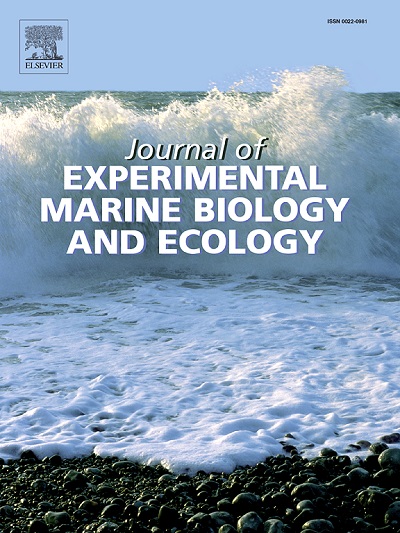Spatial distribution of the intertidal limpet Patella depressa Pennant, 1777: Patterns across wave exposure and season
IF 1.8
3区 生物学
Q3 ECOLOGY
Journal of Experimental Marine Biology and Ecology
Pub Date : 2025-01-01
DOI:10.1016/j.jembe.2024.152073
引用次数: 0
Abstract
Spatial patterns of intertidal rocky shore gastropods depend on various environmental stresses and biological interactions. Understanding how and why these patterns arise can provide important insights into the ecology and behavior of ecologically key organisms. Here, we addressed the unexplored limpet aggregative behavior and the influence of wave action and season. We assessed intraspecific patterns of the spatial distribution of Patella depressa on rocky shores of contrasting wave exposure in seasons with different levels of storminess in central Portugal. We predicted that intraspecific spatial structure estimated through individual-to-individual nearest neighbor distances (NNDs) would be more aggregated on exposed sites than on sheltered sites and, if season-dependent, such aggregation would be greater during the stormier winter months. Two sheltered sites and two exposed sites were sampled three times in winter and in summer. On each sampling occasion, the mean NNDs were measured digitally in 20 replicated random quadrats (0.25 × 0.25 m). We showed that season and exposure significantly affect the spatial distribution of limpets, with an aggregated spatial structure on exposed sites during the stormy winter months. On sheltered sites, limpets were randomly distributed regardless of season. In contrast, on exposed sites, limpets which were randomly distributed during summer changed to an aggregated structure in the winter. This is the first report of seasonally modulated patterns of spatial distribution associated with wave exposure for P. depressa. Such behavior can influence resource availability and outcomes of competitive interactions, with implications for ecosystem functioning.
彭南特潮间带帽贝的空间分布:波浪暴露和季节的模式
潮间带岩岸腹足动物的空间格局取决于各种环境压力和生物相互作用。了解这些模式是如何以及为什么产生的,可以为生态关键生物的生态学和行为提供重要的见解。在这里,我们讨论了未开发的帽贝聚集行为以及波浪作用和季节的影响。我们评估了髌骨洼地在葡萄牙中部不同风暴水平季节的岩石海岸上对比波暴露的种内空间分布模式。我们预测,通过个体与个体之间的最近邻距离(NNDs)估算的种内空间结构在暴露的地点比在隐蔽的地点更聚集,如果与季节有关,这种聚集在多风暴的冬季月份会更大。在冬季和夏季对两个隐蔽地点和两个暴露地点进行了三次采样。在每一次采样中,对20个重复随机样方(0.25 × 0.25 m)的平均NNDs进行了数字测量。我们发现季节和暴露对帽贝的空间分布有显著影响,在暴风雪冬季暴露的地点呈现聚集的空间结构。在有遮蔽的地点,帽贝不分季节随机分发。相反,在暴露地点,夏季随机分布的帽贝在冬季变成聚集结构。这是第一个与波暴露有关的空间分布的季节性调制模式的报告。这种行为可以影响资源的可用性和竞争相互作用的结果,对生态系统功能产生影响。
本文章由计算机程序翻译,如有差异,请以英文原文为准。
求助全文
约1分钟内获得全文
求助全文
来源期刊
CiteScore
4.30
自引率
0.00%
发文量
98
审稿时长
14 weeks
期刊介绍:
The Journal of Experimental Marine Biology and Ecology provides a forum for experimental ecological research on marine organisms in relation to their environment. Topic areas include studies that focus on biochemistry, physiology, behavior, genetics, and ecological theory. The main emphasis of the Journal lies in hypothesis driven experimental work, both from the laboratory and the field. Natural experiments or descriptive studies that elucidate fundamental ecological processes are welcome. Submissions should have a broad ecological framework beyond the specific study organism or geographic region.
Short communications that highlight emerging issues and exciting discoveries within five printed pages will receive a rapid turnaround. Papers describing important new analytical, computational, experimental and theoretical techniques and methods are encouraged and will be highlighted as Methodological Advances. We welcome proposals for Review Papers synthesizing a specific field within marine ecology. Finally, the journal aims to publish Special Issues at regular intervals synthesizing a particular field of marine science. All printed papers undergo a peer review process before being accepted and will receive a first decision within three months.

 求助内容:
求助内容: 应助结果提醒方式:
应助结果提醒方式:


